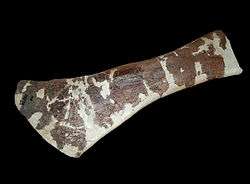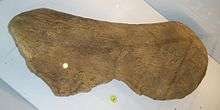Magyarosaurus
| Magyarosaurus Temporal range: Late Cretaceous, 70–66 Ma | |
|---|---|
 | |
| Humerus, Deva Natural History Museum | |
| Scientific classification | |
| Kingdom: | Animalia |
| Phylum: | Chordata |
| Class: | Reptilia |
| Clade: | Dinosauria |
| Order: | Saurischia |
| Suborder: | †Sauropodomorpha |
| Clade: | †Neosauropoda |
| Clade: | †Macronaria |
| Clade: | †Titanosauria |
| Family: | †Nemegtosauridae |
| Genus: | †Magyarosaurus von Huene, 1932 |
| Type species | |
| Magyarosaurus dacus (Nopcsa, 1915 [originally Titanosaurus dacus]) | |
| Synonyms[1] | |
|
M. hungaricus von Huene, 1932 | |
Magyarosaurus ("Magyar lizard") is a genus of dwarf sauropod dinosaur from late Cretaceous Period (early to late Maastrichtian) in Romania. It is one of the smallest-known adult sauropods, measuring only six meters in length. The type species is Magyarosaurus dacus. Magyarosaurus was found to be a close relative of Rapetosaurus in the family Saltasauridae in the sauropod clade Titanosauria in a 2005 study of the titanosaurs by Kristina Curry Rogers.[2]
Description
Magyarosaurus was estimated to be 1.1 metric tons (1.1 long tons; 1.2 short tons) in weight.[3] It carried strange dermal armour.[4][5] The estimated length of Magyarosaurus is 6 metres (20 ft), according to Curry Rogers et al..[2] In 2010 Gregory S. Paul gave lower estimations of one tonne with the same length.[6]
Stein et al. (2010) found that none of Magyarosaurus close relatives had a reduced size. That means, for its clade, its small size therefore is a distinguishing autapomorphy.[7]
A distal caudal vertebrae was named M. sp. by Codrea et al. (2008). It was probably from near the middle of the tail as it has transitional features. Before it was definitively buried, the neural arch was broken off, probably by repositioning of the vertebrae from its original position. Its centrum is elongated, and measures 105 millimetres (4.1 in) long. Both sides that would have articulated with vertebrae were severely damaged. It is assigned to Magyarosaurus on the basis that no other sauropods are known from the region it was found in, and the fact that it is located between the two vertebrae compared with it because of its intermediate morphology.[1]
Discovery

Remains belonging to at least ten individuals have been recovered from the Hunedoara region (Sânpetru Formation) in the area which was during their discovery Hungary, but is now western Romania. Initially they were named Titanosaurus dacus, the specific name referring to the Dacians (who had lived in that place about 2000 years ago), by Baron Nopcsa in 1915.[8] Nopcsa had collected fossils in the area since 1895. The species was later renamed Magyarosaurus dacus by Friedrich von Huene in 1932.[9] von Huene in 1932 also named two other species: M. hungaricus and M. transsylvanicus. Larger, rarer M. hungaricus may represent a distinct taxon.[7]
The holotype, BMNH R.3861a, consists of a set of vertebrae. Numerous other bones have been found, mainly caudal vertebrae but also dorsals and elements of the appendicular skeleton. No remains of skulls are known. There has been a discovery of 14 fossil eggs which have been attributed to Magyarosaurus.[10]

Paleontology investigations have been carried out at Râpa Roșie near Sebeş, on the southwestern side of the Transylvanian Basin. The investigations were started in 1969. Dinosaur bones were reported in earlier investigations. Based on the investigations carried out by Codrea and Dica in 2005, they have assigned the age of these formations to the Early Miocene age (also conjectured as of Eggenburgian-Ottnangian age). Some of the rare fossils found here are also vertebrates and one of these is of sauropod caudal vertebra. Paleontologists involved with the studies at Râpa Roșie have also opined that this is the only sauropod genus reported at any time in the latest Cretaceous Maastrichtian formations in Romania, which could be stated as Magyarosaurus.[1]
Paleobiology
Dwarfism
The islands it inhabited led to Magyarosaurus becoming a product of insular dwarfism as a result of selective pressures presented by limited food supplies and a lack of predators, all favoring a smaller body size.[7] This is seen in many other dinosaurs existing at the time, including the ornithopod Rhabdodon and the nodosaur Struthiosaurus. Hatzegopteryx, however, grew to giant sizes and preyed on Magyarosaurus.[3] Nopcsa was the first to suggest island dwarfism as an explanation for the small size of Magyarosaurus compared to other sauropods. Later researchers doubted his conclusions, suggesting instead that the known Magyarosaurus fossil represented juveniles. However, a detailed study of bone growth patterns published in 2010 supported Nopcsa's original hypothesis, showing that the small Magyarosaurus individuals were adults.[7][3] Island dwarfism has been suggested to have led to isolated genera retaining more primitive characteristics.[4]
Histology
.jpg)
A few years ago, Koen Stein et al. studied the histology of Magyarosaurus. They found that even the smallest individuals appeared to be adults. They also found that M. transsylvanicus and M. hungaricus were likely junior synonyms of M. dacus, but retained "M." hungaricus to represent the larger specimens that were too big to be variations of the smaller specimens. The histology of Magyarosaurus showed that it had a very reduced growth rate, but even so, had a high metabolic rate.[7]
Armour
An osteoderm discovered in the "La Cãrare" locality. The locality is near Sînpetru village, in the Hațeg Basin of Romania. The osteoderm was assigned to Magyarosaurus dacus. This shows that dermal armour had a wide distribution in these Late Cretaceous sauropods.[5] The osteoderms was peculiar in shape and size,[5] and led to eggs being assigned to its family, Nemegtosauridae, and possibly to Magyarosaurus.[4]
Possible eggs
Lithostrotian eggs have been assigned to Nemegtosauridae. The eggs possibly persist to either Magyarosaurus dacus or Paludititan, the former being more likely.[4] The Hațeg Basin was a large nesting place in the late Cretaceous, and is served as that for hadrosaurids, and titanosaurs. 11 eggs have been assigned to Nemegtosauridae, all from the Sânpetru Formation.[4] Embryos were preserved inside the eggs, and one egg shows proof of dermal armouring.[4]
The eggs were uncovered in 2001, during a field expedition by a Belgo-Romanian team. They were originally identified as in nests, but now it has been shown that no nesting structures has been preserved.[4]
Paleoecology

During the early Maastrichtian, the Hațeg Basin was subhumid, and had seasonal precipitation. However, during the later age of the formation, a large-scale paleoenvironmental change occurred, the region transformed into an extensive wetland.[11]
Magyarosaurus dacus is known from the early[11] to late Maastrichtian of the Sânpetru Formation,[2] part of the Hațeg Basin in Romania. Also known from the Hațeg Basin are the small, basal hadrosaurid Telmatosaurus;[7] the small nodosaurid Struthiosaurus;[12] the maniraptorans Balaur, Bradycneme, and Elopteryx;[12] the pterosaur Hatzegopteryx;[3][13] and the two species of the euornithopod Zalmoxes.[7]
M. sp. is known from a vertebrae. The vertebrae was found in the latest Cretaceous of the Sebeş Formation, although it was probably eroded from the Şard Formation and placed there. Alongside Magyarosaurus existed Kallokibotion, an ancient turtle;[1] Balaur, a two-clawed dromaeosaurid;[12] and Eurazhdarcho, an azhdarchid.[13] Alongside Magyarosaurus, Telmatosaurus and Zalmoxes also are dwarfed genera, as proven by their histology.[7]
References
- 1 2 3 4 Codrea, V.A.; Murzea-Jipa, C.; Venczel, M. (2008). "A Sauropod Vertebrae at Râpa Roşie (Alba District)" (PDF). Acta Palaeontologica Romaniae. 6: 43–48.
- 1 2 3 Curry Rogers, K. (2005). "Titanosauria: A phylogenetic Overview" in Curry Rogers, K. and Wilson, J.A. (eds), The Sauropods: Evolution and Paleobiology. Berkeley: University of California Press. ISBN 0-520-24623-3
- 1 2 3 4 Scott, C. (2012). "Change of Die". In McArthur, C. & Reyal, M. Planet Dinosaur. Firefly Books. pp. 200–208. ISBN 978-1-77085-049-1.
- 1 2 3 4 5 6 7 Grellet-Tinner, G; Codrea, V; Folie, A; Higa, A.; Smith, T. (2012). Andrew A. Farke, ed. "First evidence of reproductive adaptation to "island effect" of a dwarf Cretaceous Romanian titanosaur, with embryonic integument in ovo". PLoS ONE. 7 (3): e32051. doi:10.1371/journal.pone.0032051.
- 1 2 3 Csiki, Z. (1999). "New evidence of armoured titanosaurids in the Late Cretaceous - Magyarosaurus dacus from the Hateg Basin (Romania)". Oryctos. 2: 93–99.
- ↑ Paul, G.S. (2010) The Princeton Field Guide to Dinosaurs, Princeton University Press p. 213
- 1 2 3 4 5 6 7 8 Stein, K.; Csiki, Z.; Curry Rogers, K.; Weishampel, D.B.; Redelstorff, R.; Carballidoa, J.L.; Sandera, P.M. (2010). "Small body size and extreme cortical bone remodeling indicate phyletic dwarfism in Magyarosaurus dacus (Sauropoda: Titanosauria)" (PDF). Proceedings of the National Academy of Sciences of the United States of America. 20. 107 (20): 9258–9263. doi:10.1073/pnas.1000781107. PMC 2889090
 . PMID 20435913.
. PMID 20435913. - ↑ Nopcsa, F (1915). "Die Dinosaurier der siebenburgischen Landesteile Ungarns". UNGAR. GEOL. REICHSANST. 23: 1–26.
- ↑ von Huene, F. (1932). "Die fossile Reptil-Ordnung Saurischia, ihre Entwicklung und Geschichte." Mong. Geol. Pal., 4(1) pts. 1 and 2, viii +361 pp.
- ↑ "Briefing", Geology Today 7(1): p. 2-6.
- 1 2 Therrien, F.; Zelenitsky, D.K.; Weishampel, D.B. (2009). "Palaeoenvironmental reconstruction of the Late Cretaceous Sânpetru Formation (Haţeg Basin, Romania) using paleosols and implications for the "disappearance" of dinosaurs". Palaeogeography, Palaeoclimatology, Palaeoecology. 272 (1-2): 37–52. doi:10.1016/j.palaeo.2008.10.023.
- 1 2 3 Weishampel, D.B. & Jianu, C.M. (2011). Transsylvanian Dinosaurs. The Johns Hopkins University Press. pp. 37–38. ISBN 1-4214-0027-8.
- 1 2 Vremir, M. T. S.; Kellner, A. W. A.; Naish, D.; Dyke, G. J. (2013). Viriot, Laurent, ed. "A New Azhdarchid Pterosaur from the Late Cretaceous of the Transylvanian Basin, Romania: Implications for Azhdarchid Diversity and Distribution". PLoS ONE. 8: e54268. doi:10.1371/journal.pone.0054268.